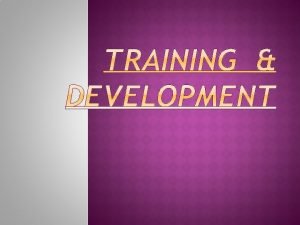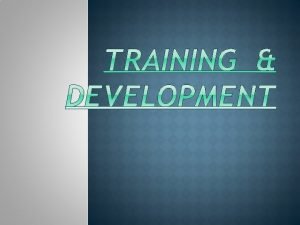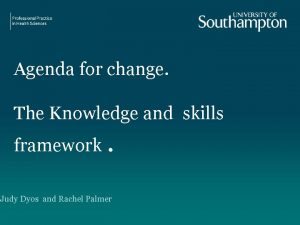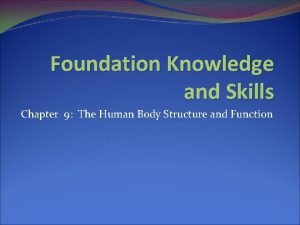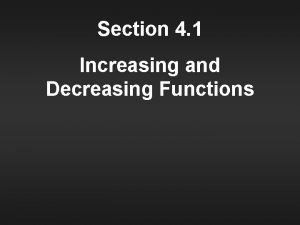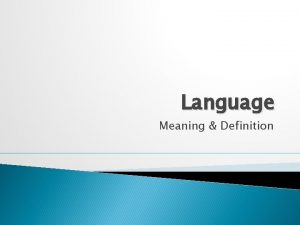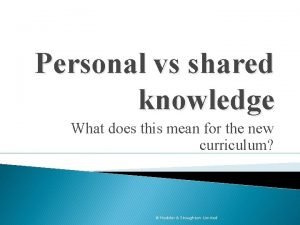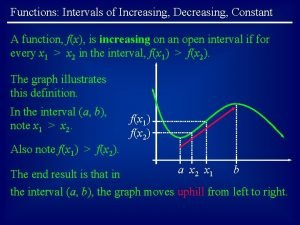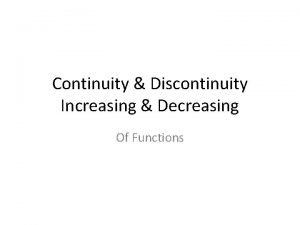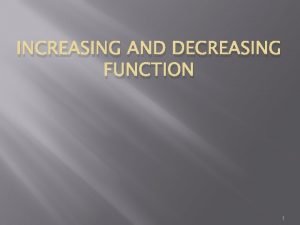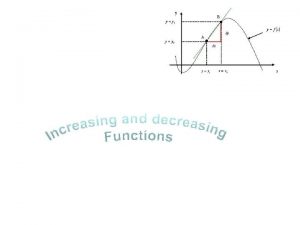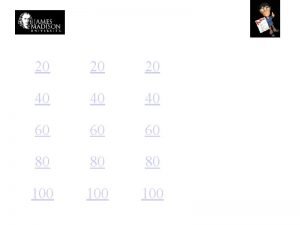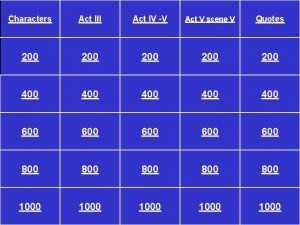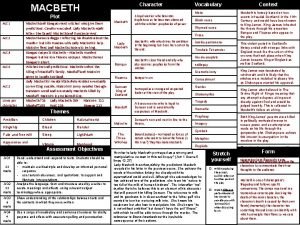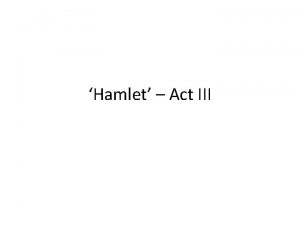The act of increasing the knowledge and skills

























- Slides: 25


� The act of increasing the knowledge and skills of an employee for doing a particular Job. � Process that tries to improve skills or add to the existing level of knowledge so that the employee is better equipped to do his present job, or to mould him to be fit for a higher job involving higher responsibilities.

� What is training? What is development? � Training: enhances the capabilities of an employee to perform his or her current job �Focuses on the current job Examples for a bank teller: � Training program to correctly identify fake currency � Training program in the bank’s new computer system used by tellers to process customer’s transactions

� Development: enhances the capabilities of an employee to be ready to perform possible future jobs �Focuses � on future jobs Developmental education programs �Examples for a bank teller: � Bank sends the teller to a day-long workshop on “Emerging Issues in Finance & Banking” � Bank pays for the employee to get his or her MBA degree � � Developmental job experiences �Examples: job rotation or job enlargement Developmental interpersonal relationships �Example: mentoring


1. Training Need Analysis (TNA) : Gap between what is currently in place and what is needed at present and in future �Organisational �Task Analysis �Man / Individual Analysis

� Environmental impact � State of economy & impact on operating cost � Changing workforce demographics & need to address cultural or language barriers � Changing technology & automation � Increasing global market places � Political trends � Organisational goals, resource availability � Climate & support for training, employee willingness to participate

� Job description � KSA Analysis � Performance standards

� Performance evaluation � Performance problems � Observation � Questionnaires � Attitude Survey � Checklist or training progress charts

Expected Curve Gap 1, 000 Cars Performanc e/Results 200 Cars Actual Curve 800 Cars Time In training terms this means we need to develop programs to fill the Gap

The reasons for not As training experts we making the 1, 000 must analyze the cars: situation to determine if: � Not enough resources � Expected result too high � Poor machines � Target achievable � Poor staff skills � Is training the only way to make it happen � Are there other factors.

�To impart induction to new employees the basic knowledge and skills required for efficient performance of the particular task �To help the employees function more effectively in their present positions by updating them the latest concepts information, techniques and developing the skills they would require in their particular field of activity. �To prepare second line of personnel �To develop competency among employees in newer areas like creativity, innovativeness etc.

Training Objectives must be specific & measurable. Why? Very difficult to measure effectiveness after course is finished. �What should trainees be able to accomplish after participating in the training program? �What is the desired level of such accomplishment, according to industry or organizational standards? �Do you want to develop attitudes, skills, knowledge or some combination of these three? 13

1. 2. 3. 4. 5. 6. Program duration Program structure Instruction methods Trainers qualification Nature of trainees Support resources – materials, OHP, classroom 7. 8. 9. Training location & environment Criteria & methods for assessing participant learning and achievement Criteria & methods for evaluating the program

� Imagine you are the training manger of a hotel that will open next year. Your GM asks you to develop a training program that aims to boost the team spirit of the newly formed Executive Committee Members. � Your GM suggests you organize a two-day course in a resort location from 9 to 5 for both days. � Your task is to suggest 3 training methods that suit the training theme described above.

Remember your training theme is to change the individuals attitudes Employ exercises that trainees can: � Participate in � React to � Provide feedback in � Receive inspiration to move on Suitable training methods you might have listed: � Role-play � Games � Simulation exercises � Discussion/debate formats � Experiential exercises � Self evaluation (e. g. video tape trainees performance & let them evaluate their own behaviors).

On-the job-training (OJT) �learn while you’re working Off -the job-training �In house, training or classroom �External, consultancies or attending external classes �Independent bodies, such as government talks �Distance learning, from books or notes �Computer-assisted learning �Interactive-video training �Video conferencing, same as classroom except teachers and students are in different locations.

�On the job Training �Off the job Training

� Job Instruction Training (JIT) � Coaching � Mentoring � Job Rotation � Apprenticeship Training � Committee Assignments

� Case Study Method � In Basket Exercise � Management Games � Vestibule training. � Role Playing. � Lecture Method. � Conference / Discussion approach � Programmed instructions.

� Training Content � Training Location � Trainer � Training Budget / Detailed costing � Lead Time

� Evaluation of Training Aspects � Assessment of Training Utility � Reaction of participants � Learning � Behaviour � Result

� Infosys plans to increase its training budget by 24% next year to $230 million and has already hiked training time from 10 weeks to 29 weeks. The head HR & Director Mr. Mohandas Pai said that Infosys plans to reward employees by offering more leadership positions.

� Indian organizations on average spent US $331 per employee on training and development in 2011, according to a study on learning and development trends in India, by the American Society for Training & Development (ASTD) and Harvard Business Publishing (HBP).

� Consulting companies like Deloitte and Pw. C say that currently, Indian IT and ITe. S companies spend between 3 -3. 5 per cent of their payroll costs in training talent.
 Training is the act of increasing the
Training is the act of increasing the Training is the act of increasing the
Training is the act of increasing the Macbeth summary
Macbeth summary Knowledge creation and knowledge architecture
Knowledge creation and knowledge architecture Public health skills and knowledge framework
Public health skills and knowledge framework Ksf band 6
Ksf band 6 Foundation knowledge and skills
Foundation knowledge and skills Foundation knowledge and skills
Foundation knowledge and skills Classify each decreasing function as having a slope
Classify each decreasing function as having a slope Example of claim of value
Example of claim of value Intrapersonal vs interpersonal communication
Intrapersonal vs interpersonal communication What are soft skills
What are soft skills What is shared knowledge
What is shared knowledge Knowledge shared is knowledge squared
Knowledge shared is knowledge squared Knowledge shared is knowledge multiplied interpretation
Knowledge shared is knowledge multiplied interpretation Contoh shallow knowledge dan deep knowledge
Contoh shallow knowledge dan deep knowledge Posteriori meaning
Posteriori meaning Street smart vs book smart
Street smart vs book smart Knowledge claim
Knowledge claim Gertler econ
Gertler econ Ska skills knowledge attitude
Ska skills knowledge attitude Knowledge vs skills
Knowledge vs skills How to find increasing and decreasing intervals on a graph
How to find increasing and decreasing intervals on a graph Decreasing intervals
Decreasing intervals Decreasing intervals
Decreasing intervals Britain diamond mining and increasing labour control
Britain diamond mining and increasing labour control
